| | Executive Summary | Table of Contents | 1.0 A General Description of the Farm Business | 2.0 The Management Team | 3.0 The Vision Statement | 4.0 The Mission Statement | 5.0 Strategic Objectives | 6.0 Financial Objectives | 7.0 Pursuing a Sustainable Competitive Advantage | 8.0 The Business Strategy | 9.0 Marketing Strategy | 10.0 Operating Plan | 11.0 Organization Plan |12.0 The Economic and Financial Plans | 13.0 Risk Management |14.0 The Decision Making Framework | Appendices
........
The purpose of this business plan is to support the decision of whether finance a land purchase by the daughter in order to retain land previously rented by the family farm business. [Covering the Period January 1, 2014 to December 31, 2015]
Executive Summary
The Father Daughter Farm is organized to efficiently crop approximately 3,000 acres. The farm is facing the choice of either purchasing 640 acres of land (630 cultivated) that previously had been rented or continuing operations with reduced crop acres. The purpose of this business plan is to assist the farm managers in the decision related to whether to finance the land purchase ($1,120,000) or to forgo the purchase and operate on fewer acres.
The future vision for the farm business is to be a viable and sustainable business managed by the daughter. The overall business strategy is to continue developing the farm business as a knowledge driven organization that focuses on achieving acceptable financial returns at acceptable levels of risk.
The financial projections suggest that the farm business could achieve acceptable returns and maintain strong liquidity and solvency positions while financing the land purchase. Key elements that would contribute to this desired outcome would include:
- Gaining knowledge of price and delivery opportunities that enables the farm business to capture target prices.
- Gaining knowledge of customer needs that enables the farm to be a preferred supplier by providing customers with superior quality and value.
- Gaining a detailed understanding of cost drivers that enables the farm to consistently achieve low cost crop production.
- Continuously monitoring financial performance of the farm business in order to respond to variability and unplanned shocks.
- Continuously identifying, assessing and managing risk events in order for the farm managers to be able to take the right action at the right time.
Table of Contents
Executive Summary
Table of Contents
1.0 A General Description of the Farm Business
2.0 The Management Team
3.0 The Vision Statement
4.0 The Mission Statement
5.0 Strategic Objectives
6.0 Financial Objectives
7.0 Pursuing a Sustainable Competitive Advantage
7.1 External Analysis
7.2 Internal Analysis
7.3 Key Success factors
7.4 The Competitive Edge
8.0 The Business Strategy
9.0 Marketing Strategy
10.0 Operating Plan
11.0 Organization Plan
12.0 The Economic and Financial Plans
13.0 Risk Management
14.0 The Decision Making Framework
Appendix A – The Farm Resources
Appendix B –Historical Financial Performance
Appendix C - Current Financial Position of the Father Daughter Farm
Appendix D – Payment Schedule for Proposed Term Loan
Appendix E – Projected Financial Performance
1.0 A General Description of the Farm Business
- The Father Daughter farm business is currently operated as a partnership between the father and the mother with the daughter being actively involved in management decisions. The longer term objective is for the daughter to assume management responsibilities and ownership.
- With the purchase of 640 acres of land, the farm would own 2245 acres of owned land with 2192 acres cultivated in east central Alberta. An additional 800 acres is cash rented with 760 acres being cultivated land.
- The farm is facing the choice of either purchasing 640 acres of land (630 cultivated) that previously had been rented (purchase price of $1,120,000) or continuing operations with reduced crop acres.
- The farm is organized to efficiently crop in the range of 3,000 cultivated acres. Forgoing the opportunity to buy the 640 acres and operating at reduced acres could adversely impact the efficiency of the farm operations and possibly limit the ability of the farm business to pass ownership and management from one generation to the next.
- The financing terms available to the daughter to make this purchase would be $1,120,000 at 3.5% over 20 years with semi-annual payments (blended) of $39,168.74 providing the father offers additional land (320 acres) as security for the loan.
- The purpose of this business plan is to explore how the additional debt servicing requirements (approximately $82,000 per year) would impact the whole farm business. As well to determine if the additional debt will adversely impact on the objective of maintaining a strong financial position along with the ability to deal with unexpected shocks emanating from a dynamic and changing business environment.
- The farm cropping program includes canola, wheat and peas.
- The strength of the farm business has been maintaining a strong financial position combined with consistently strong production capabilities.
- The farm has a complete line of modern cropping equipment including a GPS navigation system that supports auto steer and precision placement technologies.
- The farm has a modern home along with grain storage, fertilizer storage and machinery storage.
- The daughter has completed an agriculture management diploma at the Olds College and initially will draw wages as an employee of the farm business. As well, she has past experience working for a local business and will return to this business in order to earn off-farm wages over the winter months.
2.0 The Management Team
- The father has 25 years of farming experience and 20 years managing the current farm business. Up until the last three years, he has been responsible for all management activities including monitoring financial performance, crop marketing decisions as well as organizing cropping and harvest operations and
- The daughter has actively participated in the management of the farm business over the past three years by providing economic and financial analyses to key decisions. Her college training has enabled her to develop skills in both production and business management.
- The father and the daughter have worked closely with a grain market advisor who has assisted them in determining break-even costs, developing and implementing marketing strategies as well as identifying price and delivery opportunities.
- The farm records are maintained by a local bookkeeper. The accounting is handled by a firm in Stettler. The father and daughter have had annual reviews with the accountant in order to gain insight on the financial structure and performance of the farm business over time.
- The father and daughter have worked closely with an independent agronomist to implement a soil testing program as well as develop cropping and fertility plans.
- In the longer term the business objective is for the daughter to take over all management activities and ownership of the farm business.
The action steps to facilitate the process of the daughter assuming a management role in the business include the following:
- The father and daughter will invest time and energy in assessing the industry, the market, and the competition for resources that will shape the future business environment their farm business will have to operate in. This will enable them to consider the role the future farm business will have in the future industry.
- The father would support the daughter in gaining the financing of $1,120,000 to purchase 640 acres by providing an additional 320 acres of land as security for the loan.
- The father will take steps to transition the relationships with lenders and other stakeholders to the daughter.
- The daughter will take steps to monitor cost per unit of production, gain insights on key cost drivers and continuously make improvements to reduce costs per unit of production.
3.0 The Vision Statement
The future vision for the farm business is to be a viable and sustainable business managed by the daughter. In the dynamic and changing business environment the focus will be on maintaining a strong financial position in order to be prepared for multiple possible outcomes. Specific actions include the following:
- The farm will maintain its focus on crop production and continuously pursue above average crop production performance.
- The farm will take steps to gain detailed knowledge of cost drivers and cost control procedures that can contribute to low cost production.
- The farm will continuously undertake to identify and realize opportunities to provide commodities with enhancing features that lower transaction costs for buyers.
- The farm will continuously monitor financial performance in order to ensure a strong working capital position and strong overall financial position.
4.0 The Mission Statement
The current farm business has achieved strong solvency and liquidity positions though the cumulative effect of recent years of good crops and prices combined with reasonable levels of debt and modest withdrawals of capital from the business. In addition the farm has been able to upgrade the field equipment to take advantage of modern technological advances including GPS navigation systems, auto steer and precision placement of fertilizer.
The working relationship between working relationship between the father and daughter is very strong with a shared view of the importance of maintaining the strong financial position of the farm through astute financial management and agility.
5.0 Strategic Objectives
The farm business strategy is to utilize knowledge to achieve the multiple objectives of acceptable financial returns at acceptable levels of risk while passing management and ownership to the daughter. Critical activities for the farm business will be:
- Continually identifying and assessing opportunities to achieve superior crop production performance with an emphasis on low cost production.
- Continually identifying and assessing technological advances for opportunities to improve whole farm performance.
- Continuously gaining market knowledge that allows the farm to provide crops of superior quality and value that improve the well-being of the customers in specific market segments.
- Continuously identifying, assessing and managing risk events that if they were to occur could have an impact (either positive or negative) on the goals and objectives of the farm business.
- Continuously gathering feedback on management performance and whole farm performance in order to learn not only what happened but more to understand why various outcomes occurred.
6.0 Financial Objectives
Financial success for the whole farm business will be maintaining a strong financial position by ensuring the farm has the financial capacity to remain viable and sustainable while dealing with the year to year variability in prices and costs that as well as the shocks emanating from social, economic, political and environmental forces. Accordingly key financial activities and objectives will be:
- Ensuring the farm business has sufficient capacity to finance the land purchase as well as maintain liquidity and solvency measures sufficient to recover from significant shortfalls in production or market prices as well as deal with unexpected shocks emanating from social, economic, political and environmental forces.
- Achieve efficient use of resources that contributes to long term growth in net worth.
- Achieving profitability and cash flow performance that ensures a strong working capital position.
7.0 Pursuing a Sustainable Competitive Advantage
The farm managers recognize that there will be competition for owned and rented land in their district. As well there will be competition for other inputs including capital as well as in gaining access to various market segments. In this environment the challenge for the farm business will be competing for resources without exposing the farm business to unacceptable levels of risk. Specifically the farm will have to compete for land without sacrificing the strong financial structure including a strong working capital position.
7.1 External Analysis
The farm business is part of an increasingly complex system with many inter-connected and interdependent components including social, economic, political and environmental elements. The interaction among the key elements in this system will affect the viability and sustainability of the farm business. Key drivers shaping the external environment include:
- The commodity cereals, oilseed and pulse crop markets tend to be dominated by large multi-national firms in which the primary producer is a price taker.
- Technology is will continue to advance and generate opportunities for increased productivity and for providing attributes that can enable the farm to provide a superior value/cost equation to customers .
- A growing population will likely continue to drive food production. However there will be increased variability in market prices.
- Society’s concerns for the environment will contribute to greater consumer and regulatory forces shaping resource use and the impact production practices have on natural resources and the environment.
- There will be increased competition for the key resources of land, capital and energy.
- Interest rates have been favorable over the past five years. However there is no certainty that this will continue. An increase in interest rates of 1.5% on the $1,120,000 being considered would cause annual payments to increase by an estimated $11,100 per year and total interest costs over 20 years to increase by an estimated $221,350.
The farm managers recognize that the farm business has a unique combination of strengths and weaknesses that will impact on its ability to compete with other farm businesses in the region and in the larger business environment. They recognize that a competitive edge will be achieved by building on what is working in the farm business while taking steps to overcome weaknesses in the business.
7.2 Internal Analysis
The strengths and limitations that could impact on the competitive position of the farm business include:
- The past reliance on rented land has allowed the farm to develop the cropping enterprise without incurring significant levels of debt. However this has made the farm vulnerable to losing substantial acres when landlords choose to sell their land. The purchase of land that is available to the farm at this time will provide land tenure and lessen the vulnerability of losing crop production acres.
- The farm has been progressively investing in modern crop technologies which combined with strong organizational capacities have contributed to above average crop production capabilities. If the farm were to take on more land debt it may not be able to continue with aggressively adopting new technology that requires capital purchases and debt financing. However the modern line of equipment does provide the potential for the farm to pursue custom work (both seeding and harvest) as a means of generating additional revenues.
- The farm has been able to achieve above average crop production along with below average costs. As well, the farm has been able to provide the market with crops of superior quality and value at a lower cost of production than competitors.
- The farm business has developed a culture of learning and knowledge that has enabled it to be flexible, creative and well prepared to respond to changes emanating in the external environment.
- Working with the marketing advisor, the farm has been able to identify price and delivery opportunities as well as become a preferred supplier that can reliably meet contract terms specifying quantity and quality.
- The increased level of debt required to replace land currently being rented will place the farm in a changed financial situation. Rather than paying cash rent in the range of $50 per acre the farm would have financing costs (Principal plus interest) of $125 per acre on the 630 acres. This change in the financial structure of the business can impact on the ability to recover from significant shortfalls in production or market prices.
- The daughter’s ability to gain off-farm work during the winter months could reduce the level of wages that would have to be paid to her from $35,000 per year to $14,000.
7.3 Key Success factors
The farm business will continue to implement the following practices that enhance its ability to achieve financial success while making progress to the longer term objectives of passing the farm business to the daughter.
- Decision making will continue to balance the multiple objectives of achieving economic returns, managing financial risk as well as ensuring strategic and organizational fit.
- Implementing risk management processes that enhance the ability of the farm managers to recognize and capture opportunities and mitigate threats more quickly than rivals.
- Continuing to work with the accountant to monitor the financial performance of the farm business in order to have the information needed to pursue the objectives of maintaining a strong financial position and the capacity to deal with variability in production results and market prices.
- The managers will continue to work with the agronomist to implement crop production practices that contribute to higher productivity levels and lower costs per unit of production.
- The daughter will continue to assess key cost drivers and identify innovative ways to manage production costs.
- The managers will continue working with the market advisor to use contracting to capture market opportunities.
- The managers will maintain the modern equipment with the capacity to take on additional acres and generate additional revenues through custom work in the right situation.
7.4 The Competitive Edge
The farm managers will continue developing a competitive edge through knowledge and learning that enables the farm business to take the right action at the right time. These knowledge advantages include the following:
- Gaining knowledge of price and delivery opportunities that enables the farm business to capture target prices.
- Gaining knowledge of customer needs that enables the farm to be a preferred supplier by providing customers with superior quality and value.
- Gaining a detailed understanding of cost drivers that enables the farm to consistently achieve low cost crop production.
- Continuously monitoring financial performance of the farm business to ensure it maintains a strong financial position with the ability to deal with year to year variability and unplanned shocks.
- Continuously identifying, assessing and managing risk events in order for the farm managers to be able to take the right action at the right time.
8.0 The Business Strategy
The overall business strategy is to continue developing the farm business as a knowledge driven organization that focuses on maintaining a viable and sustainable business that can be passed to the daughter. Critical activities focus on maintaining financial strength, having the capacity to finance land purchases and ensuring sufficient resiliency to deal with unexpected shocks and stresses. These include:
- To continue monitoring the financial performance of the farm business and ensuring it sustains a strong financial position that deals with variability in the short run and future ownership changes in the long run.
- To continue investing in crop production technologies that contribute to achieving acceptable return to total farm assets at acceptable levels of risk.
- Leverage marketing knowledge and resources to identify price and delivery opportunities as well as provide crops with enhancing features such as delivery of large lots that lower transaction costs.
9.0 Marketing Strategy
The farm business will implement marketing strategies that focus on identifying and realizing pricing and delivery opportunities for the grain, oilseed and pulse crops. This strategy would have the following elements:
- Continue working with market advisor to leverage a strong knowledge of price patterns, local basis levels and patterns, marketing tools and sources of market information to capture pricing and delivery opportunities.
- To continue using of production costs to determine break even prices and establishing target prices for crops and livestock.
- Take time to learning from past marketing decisions in order to understand why past decisions were not effective.
10.0 Operating Plan
The farm business has developed the following resource base.
- With the purchase of the additional 640 acres the farm would consist of 2245 acres of owned land of which 2192 are cultivated. An additional 800 acres are cash rented with 760 acres of cultivated land. The land is located in an area where rainfall is considered to be the main limitation.
·Appendix A presents detailed information of the farm resources.
- The key objectives and action plans for the operations component of the farm business are as follows:
- The crop production system is a zero tillage rotation with inputs applied to achieve economic returns. The father and daughter have recently changed their input philosophy from fertilizing to achieve target yields to one of fertilizing to achieve $2 in added revenues for every $1 of added fertilizer.
- The father, daughter and agronomist will continue to assess the net benefits of adopting new technologies. Those technologies that have a reasonable likelihood of contributing to %ROA at acceptable risk and fit with the organization and operations of the farm business will be adopted and implemented.
- The daughter will continue to assess the key cost drivers in crop production in order to identify opportunities to reduce the cost of production.
11.0 Organization Plan
The key objectives and action plans for the organization component of the farm business are as follows:
- The father and mother will continue to operate the farm as partnership with the longer term (5 to 10 years) objective of passing ownerships to the daughter.
- The daughter is currently an employee of the farm business drawing a set wage of $35,000 per year while living at home. She has the opportunity to pursue off-farm work during the winter season which could reduce the wage costs to $14,000 per year.
- The father anticipates having a reduced workload on the farm in the next 10 years. Accordingly there may be a need for additional hired help during seeding and harvest. The daughter recognizes the need to develop the leadership qualities required to organize operations and effectively manage hired employees.
- The farm has a strong network of advisors including a bookkeeper, accountant, agronomist and market advisor. The father and daughter will continue to work closely with these resource people in order to identify, assess and realize opportunities that may arise.
- The father has managed the relationship with lenders to this point in time. Going forward the father will transition these relationships with lenders and other stakeholders to the daughter.
- The daughter has been active in decision making over the past two years. Going forward they will continue to work together planning and decision making activities with the daughter taking over all decision making in 8 to 10 years.
12.0 The Economic and Financial Plans
The business model for making money will be based on the following key assumptions:
The expected values for crop prices for the 2014 crop year are:
Table 12.1: Expected Values for 2014 Crop Prices
Canola | HRS Wheat | Peas |
Price Probability | Price Probability | Price Probability |
$/bu | chance | weighted value | $/bu | chance | weighted value | $/bu | chance | weighted value |
| $9.50 | 15% | $1.43 | $5.50 | 20% | $1.10 | $6.50 | 15% | $0.98 |
| $10.00 | 20% | $2.00 | $5.75 | 20% | $1.15 | $6.75 | 25% | $1.69 |
| $10.50 | 25% | 2.63 | $6.00 | 25% | $1.50 | $7.00 | 25% | $1.75 |
| $11.00 | 25% | $2.75 | $6.25 | 25% | $1.56 | $7.25 | 20% | $1.45 |
| $11.25 | 15% | $1.68 | $6.50 | 10% | $0.65 | $7.50 | 15% | $1.13 |
 | 100% |  |  | 100% |  |  | 100% |  |
| Weighted Price | $10.49 | /bu | Weighted Price | $5.96 | /bu | Weighted Price | $6.99 | /bu |
Table 12.2: Expected Values for 2015 Crop Prices
Canola | HRS Wheat | Peas |
Price Probability | Price Probability | Price Probability |
| $/bu | chance | weighted Value | $/bu | chance | weighted value | $/bu | chance | weighted value |
| $10.00 | 15% | $1.50 | $5.75 | 15% | $0.86 | $7.00 | 15% | $1.05 |
| $10.50 | 20% | $2.10 | $6.00 | 20% | $1.20 | $7.25 | 25% | $1.81 |
| $11.00 | 25% | $2.75 | $6.50 | 20% | $1.30 | $7.250 | 25% | $1.88 |
| $11.50 | 25% | $2.88 | $7.00 | 25% | $1.75 | $7.75 | 20% | $1.55 |
| $12.00 | 15% | $1.80 | $7.50 | 15% | $1.13 | $8.00 | 15% | $1.20 |
 | 100% |  |  | 95% |  |  | 100% |  |
| Weighted Price | $11.03 | /bu | Weighted Price | $6.24 | /bu | Weighted Price | $7.49 | /bu |
The expected production, price and operating costs for each crop in the 2014 crop year are as follows:
Table 12.3: Expected Crop Yields, Crop Prices and Operating Costs for 2014
| Projected Crop Production 2014 | Canola | HRS Wheat | Peas | Totals |
| Acres | 1450 | 1350 | 150 |  |
| Price | $10.49 | $5.96 | $6.99 |  |
| Yield | 40 | 45 | 45 |  |
| Value of Production ($/acre) | $420 | $268 | $315 | $1,017,673 |
| Total Variable Costs | $309.40 | $249.20 | $210.25 | $816,588 |
| Total Cash Fixed Costs | $23.75 | $23.75 | $25.00 | $70,250 |
| Total Cash Expenses | $333.15 | $272.95 | $235.25 | $886,838 |
| Margin | $86.45 | -$4.75 | $79.30 | $130,835 |
 |  |  |  |  |
| Break-Even Selling Prices | Canole | HRS Wheat | Peas |  |
| To Cover all Cash Costs | $8.33 | $6.07 | $5.23 |  |
The expected production, price and operating costs for each crop in the 2015 crop year are as follows:
Table 12.4: Expected Crop Yields, Crop Prices and Operating Costs for 2015
| Projected Crop Production 2015 | Canola | HRS Wheat | Peas | Totals |
| Acres | 1350 | 1450 | 150 |  |
| Price | $11.03 | $6.24 | $7.49 |  |
| Yield | 42.00 | 48.00 | 44.00 |  |
| Value of Production ($/acre) | $463 | $300 | $330 | $1,109,139 |
| Total variable costs | $308.15 | $248.00 | $209.00 | $806,953 |
| Total Cash Fixed Costs | $23.75 | $23.75 | $25.00 | $70,250 |
| Total Cash Expenses | $331.90 | $271.75 | $234.00 | $877,203 |
| Margin | $131.36 | $27.77 | $95.56 | $231,937 |
 |  |  |  |  |
| Break-Even Selling Prices | Canola | HRS Wheat | Peas |  |
| To Cover all Cash Costs | $7.90 | $5.66 | $5.32 |  |
The past financial performance has been strong and has contributed to the current financial position of the farm business (presented in Appendices B and C). The current position of the farm business is indicated by the following measures of financial structure.
Table 12.5: Liquidity and Solvency Measures of the Current farm Business
| Current Ratio: | 4.88 |
| Debt to Equity Ratio: | 0.25 |
| Equity to Assets Ratio: | 0.80 |
| Solvency Ratio: | 0.20 |
| Working Capital | $886,214 |
The expected prices (2014) and operating costs are used to assess the potential economic effects of purchasing the land versus operating with reduced acres. These are summarized in table 12.6.
Table 12.6: The Whole Farm Economics Effects of Purchasing Land Compared With Not Purchasing Land
| | No Purchase | Purchase 640 Acres |
| Total Crop Acres | 2320 | 2950 |
| Total Accrued Farm Income | $937,778 | $1,157,378 |
| Total Accrued Expenses | $831,957 | $953,817 |
| Net Accrued Farm Income | $105,821 | $203,561 |
| Debt Servicing Capacity Ratio | 0.97 | 1.46 |
| % Return on Assets | 1.48% | 2.97% |
The focus of this assessment is on the two choices that are available to the farm. These are to either finance the land purchase or to forgo the purchase and operate on fewer acres. This comparison suggests that even with the added interest costs associated with financing the land, the net accrued farm income and % Return on Assets are greater when the land is purchased. Even though the economic assessments favor purchasing the land the key issue for the farm business will be the effects on financial performance and maintaining financial strength.
The expected financial performance for the farm business over the next two years is presented in Appendix E. These projections include the following key assumptions:
- The daughter purchases 640 acres of land (630 acres cultivated) on April 1, 2014 for $1,120,000.
- A term loan of $1,120,000 is advanced on April 1, 2014 to finance the land purchase. The loan semi-annual loan payment of $39,168.74 commence on December 15, 2014. (See Appendix D)
- The farm achieves the crop yields and prices presented on the previous page of this document. (Tables 12.3 and 12.4)
- Other than approximately $9,100 all revenues received by the farm are from the cropping enterprise.
- The daughter receives wages of $35,000 per year while living at home which are included as an expense.
- The father and mother require $55,000 for living requirements which is treated as a draw from net profit.
The expected profitability performance and cash flow performance (Appendix E) are considered to be reasonable for the current farm business.
Of note is that the expected values for crop prices used in these forward projections reflect the weighted average of a range of possible prices along with the considered probability attached to each by the farm managers (Tables 12.1 and 12.2). Accordingly these values do consider the range of possible prices.
The forward projections have resulted in the following key indicators of expected financial performance and financial structure based on the scenario of financing the purchase of the 640 acres.
Table 12.7 Indicators of Financial Performance Over two Years of Operation with Debt
| Key Indicators of Financial Performance | For the Year Ending December 31,2014 | For the Year Ending December 31, 2015 |
| Net Accrued Farm Income | $203,561 | $165,759 |
| %ROA | 2.97% | 2.58% |
| Debt Servicing Capacity Ratio | 1.46 | 1.26 |
Table 12.7 Indicators of Financial Structure After Two Years of Operation with Debt
| Key Indicators of Financial Structure | December 31 | December 31, 2014 | December 31, |
| Current Ratio | 4.88 | 4.64 | 4.64 |
| Net Worth Ratio | 80.00% | 68.00% | 70.00% |
| Working Capital | $888,214 | $939,947 | $999,374 |
| Working Capital as % of Operating | 92.90% | 94.90% | 100.90% |
These projections suggest that the farm business could achieve acceptable returns and maintain strong liquidity and solvency positions while financing the land purchase.
The farm business also recognizes that carefully monitoring and managing the financial performance of the farm business will be a critical element in ensuring the farm is able to deal with variability in yields and prices and achieving financial success. In the coming year the daughter will take responsibility for implementing the following actions:
- Develop forward financial projections for the business in order to gain an assessment of expected outcomes for profitability, cash flows and financial structure.
- Work with the bookkeeper to gain quarterly income statements and develop budgeted versus actual assessments in order to monitor financial performance on an ongoing basis and update forward plans when necessary.
13.0 Risk Management
Risk management is a key factor in the overall strategy of being prepared for a range of possible outcomes during the period when the farm business has taken on the new debt.
A key source of uncertainty will be variability in crop yields and market prices. Production risk in crops will be managed through full use of crop insurance available through Agriculture Financial Services Corporation (AFSC). The daughter will take steps to ensure her name is on the crop insurance contract so that she will have the index and discounts earned by the father when she is the sole operator.
The management team has used the Crop Choices tool (Version 3.8) to consider the impact that variability in yields and crop prices might have on the financial performance of the farm business. Specific elements of note in using Crop Choices to make this assessment are:
1.Since the farm business is essentially a crop enterprise the assessment provided by Crop Choices reflects the impacts of yield and price variability on the whole farm business.
2.The assessment provided by the tool considers the coverage levels provided by purchasing crop insurance.
3.The assessment recognizes the correlations between yields and prices.
In order to assess possible outcomes due to variability in crop prices and yields the farm managers compared three possible scenarios for the farm business.
Scenario 1 is based on 2320 acres in crop with principal payments on existing debt of $137,051 per year; cash rent costs of $38,000 per year, interest on capital debt of $20,000 per year and wages to the daughter amounting to $35,000 per year. The required target for gross margin would be the total of principal payments plus the draw for living ($55,000) by the father which in this scenario is ($137,051 + $55,000) = $192,051.
The second scenario (Scenario 2) would be based on financing the purchase of the 640 acres. Accordingly, the total crop acres would be 2950, the total principal payments would be $175,214 per year, the cash rent costs would be $38,000 per year, the interest on capital debt would be in the range of $57,000 per year and the wages to the daughter would be $35,000 per year. The targeted gross margin in this scenario is ($175,214 + $55,000) =$230,214.
The third scenario (Scenario 3) would include the land purchase (2950 crop acres), the higher debt ($175,214 in principal payments, interest on capital debt of $57,000 per year and wages to the daughter of $14,000 per year. The targeted gross margin in this scenario is ($175,214 + $55,000) =$230,214.
The farm managers provided the following yield and price parameters to be used in the simulation run by the Crop Choices tool.
Table 13.1 Yield and Price Parameters Used in Crop Choices Simulations
 | Yield Parameters |
| Crop | Worse Possible | Best Possible | Most Likely |
| Canola | 35 | 46 | 40 |
| HRS Wheat | 38 | 48 | 45 |
| Peas | 40 | 48 | 44 |
 |  |  |  |
 |  |  |  |
 | Price Parameters |
| Crop | Worse Possible | Best Possible | Most Likely |
| Canola | $9.50 | $11.25 | $10.50 |
| HRS Wheat | $4.50 | $6.50 | $6.00 |
| Peas | $6.50 | $7.50 | $7.00 |
The simulations generated the following assessments of gross margins and risk.
Table 13.2: Expected Gross Margins and Risk
 | Scenario 1 | Scenario 2 | Scenario 3 |
| Expected Gross Margin | $151,557 | $187,715 | $213,782 |
| Standard Deviation of GM | $73,404 | $89,937 | $93,867 |
| Chance of GM Below $192,051 | 69.74% |  |  |
| Chance of GM Below $230,214 |  | 67.80% | 57.75% |
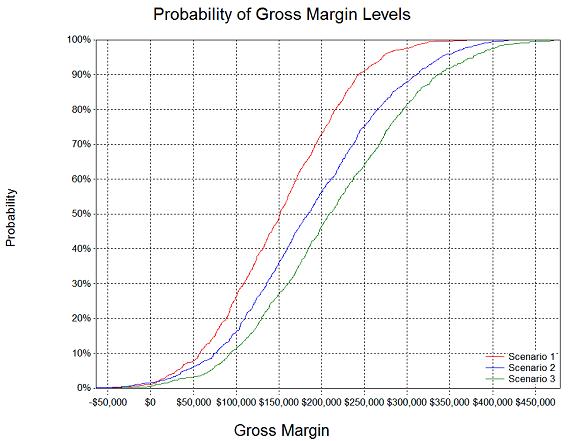
These assessments suggest that the probability of Scenario 3 achieving less than the targeted Gross Margin of $230,214 is 57.75% while the probability of Scenario 2 achieving less than the same targeted Gross Margin is higher at 67.80%. The probability of Scenario 1 not achieving its targeted Gross Margin of $192,051 is 69.74%. These simulation results indicate that there is a level of risk in not achieving the Gross Margin required to cover principal payments and living requirements of the father and mother even with the reduced wages paid to the daughter.
The management team recognizes that financing the land purchase does expose the farm business to the risk of variability in prices and yields which will in turn impact on profitability, cash flow performance, debt servicing capacity and overall financial structure. However this risk may not be substantially greater than the risk attached to continuing to operate with fewer cultivated acres.
This has led the farm managers to consider strategies that might be needed to be implemented in order to increase cash revenues and maintain a strong working capital position. One alternative is to utilize the line of equipment to take on some custom work during the spring and fall. If this activity was implemented and netted $15,000 the targeted Gross Margin would be reduced to $215,214 and the probability of not achieving this level would be 51.72%
To further manage the impact of the risk attached to variability in crop prices the farm managers will take action to continue working with the market advisor to identify, assess and capture price and delivery opportunities. The Spring Price Endorsement (SPE) available with crop insurance will be evaluated along with forward pricing and delivery alternatives.
In order to be better prepared for these possible outcomes the managers and the daughter in particular will frequently monitor projected as well as actual financial performance. The focus is to ensure the managers are able to recognize and mitigate threats to financial performance and structure sooner rather than later.
The management team will also undertake apply risk thinking into all key decisions. This would include incorporating processes of identifying, assessing and managing risk when dealing with the marketing and agronomic advisors. Furthermore, farm safety will be given a high priority in all aspects of operations. An initial assessment of risk events that might impact on the objectives of the farm business along with possible strategies and the individual responsible is as follows:
| Potential Risk Events | Risk Strategy | Responsibility |
| Reduced Working Capital | Early identification. Utilize Agrinvest funds. Reduce draw for living. Continuously assess the opportunities for doing custom work and how this might impact on farm operations and finances. | Father and Daughter working with accountant |
| Reduced Financial Strength | Postpone new machinery purchases during periods of reduced income. Reduce the outflow of capital to provide living to father and mother. | Father and Daughter working with accountant |
| Crop price variability | Work with market advisor to identify price opportunities. Utilize Spring Price Endorsement (SPE) component of crop insurance. | Daughter |
| Reduced access to key inputs including capital | Continue developing strong relationships based on respect and information exchange. Apply fertilizer in fall as a means of gaining fall prices with limited storage costs. | Father transitioning to daughter |
| Changing land use regulations including fertilizer practices. | Monitor changes in regulations and work with agronomist to determine options available for dealing with regulations impacting on fertilizer use. | Daughter |
| Increased competition for rented land | Continue to build relationships with landlords taking time to understand what they value most in a rental relationship. | Father transitioning to daughter |
| Changing policy and trade factors. | Take time to monitor events in the policy and trade arenas that might impact on farm business objectives. | Father |
| Changing land use regulations including fertilizer practices. | Monitor changes in regulations and work with agronomist to determine options available for dealing with regulations impacting on fertilizer use. | Daughter |
| Health and Safety Risks | Father and daughter to take time to consider safety issues and how to implement safety practices. | Father and Daughter |
| Hazards | Annual meetings with insurance agent to ensure coverage is appropriate for changing circumstances | Father transitioning to daughter |
14.0 The Decision Making Framework
The following framework incorporates the multiple objectives the father and daughter are seeking for the business into the decision of whether to finance a land purchase along with a weighting and impact score for each. The % Score provides a composite measure that reflects an overall score for the decision that reflects the weighting and scoring of each of the objectives the farm business would consider in the decision.
The threshold set by the farm managers for the decision to finance a land purchase is 80%. Accordingly, in the decision of whether to finance the purchase of land that had been rented they feel the scoring at that time would have to achieve a score of at least 80%. At this time based on the assumed land purchase price and financing terms, the decision to proceed with financing the land purchase appears to score at an acceptable level.
| Factors | Weighting | Impact Scoring | Weighted Score | Max. Possible | %Score |
| Economic Attractiveness | 30.00% | 4 | 1.20 | 1.5 |  |
| Financial Attractiveness | 30.00% | 4 | 1.20 | 1.5 |
| Risk | 20.00% | 3 | 0.60 | 1 |
| Strategic Fit | 10.00% | 5 | 0.50 | 0.5 |
| Organizational Desirability&Fit | 10.00% | 5 | 0.50 | .5 |
| Total | 100.00% |  | 4.00 | 5 | 80.00% |
Impact Scoring Guide |
| Impact | Score |
| Significant impact on the achievement of farm business goals and objectives | 5 |
| Considerable impact on farm business goals and objectives | 4 |
| Modest impact on farm business goals and objectives | 3 |
| Limited impact on farm business goals and objectives | 2 |
| Negligible impact on farm business goals and objectives | 1 |
Appendix A – The Farm Resources
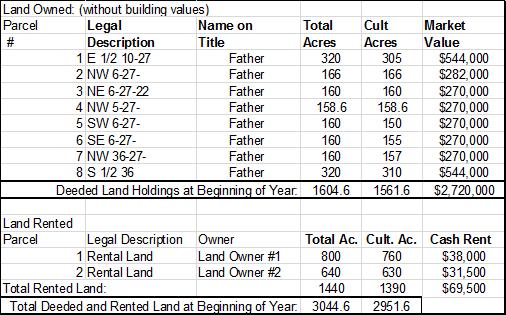
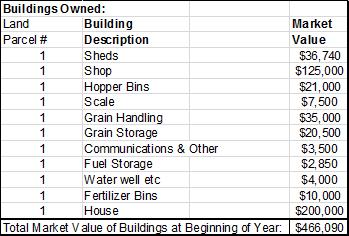
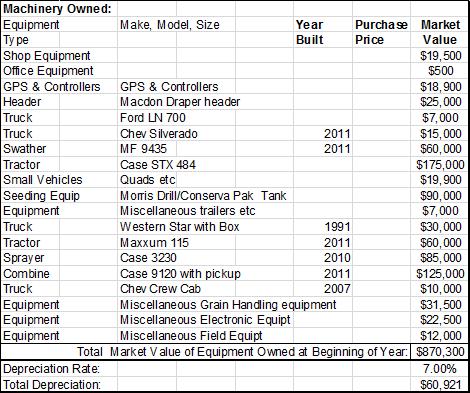
Appendix B –Historical Financial Performance
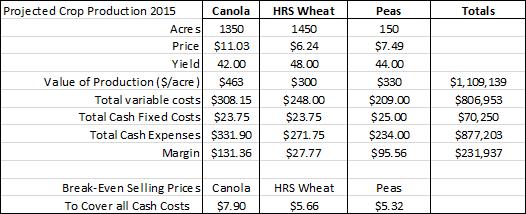
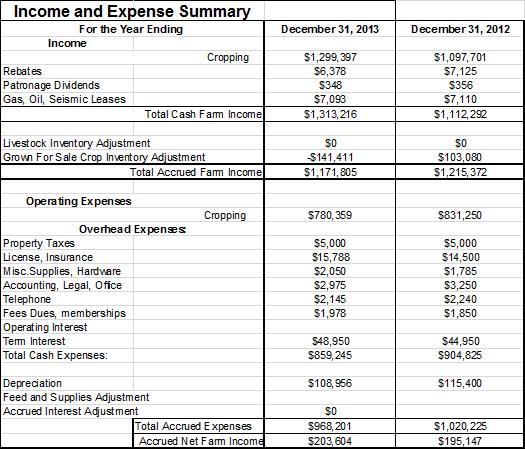
Appendix C - Current Financial Position of the Father Daughter Farm
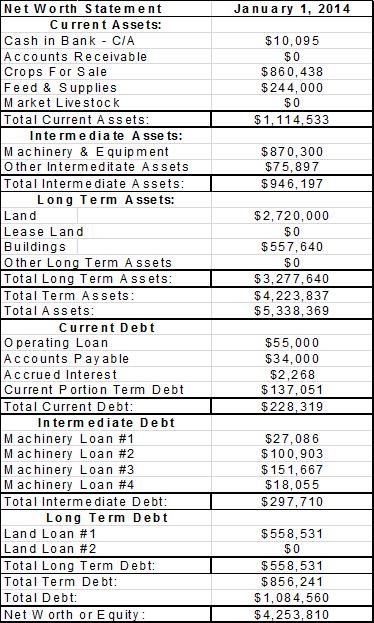
Appendix D – Payment Schedule for Proposed Term Loan
Payment | Payments | Interest | Principal |
Period | to date | to date | to Date |
0 | $0.00 | $0.00 | $0.00 |
1 | $39,168.74 | $19,600.00 | $19,568.74 |
2 | $78,337.48 | $38,857.55 | $39,479.93 |
3 | $117,506.22 | $57,766.65 | $59,739.57 |
4 | $156,674.96 | $76,321.21 | $80,353.75 |
5 | $195,843.70 | $94,515.02 | $101,328.68 |
6 | $235,012.44 | $112,341.77 | $122,670.67 |
7 | $274,181.18 | $129,795.03 | $144,386.15 |
8 | $313,349.92 | $146,868.27 | $166,481.65 |
9 | $352,518.66 | $163,554.84 | $188,963.82 |
10 | $391,687.40 | $179,847.97 | $211,839.43 |
11 | $430,856.14 | $195,740.78 | $235,115.36 |
12 | $470,024.88 | $211,226.26 | $258,798.62 |
13 | $509,193.62 | $226,297.28 | $282,896.34 |
14 | $548,362.36 | $240,946.59 | $307,415.77 |
15 | $587,531.10 | $255,166.81 | $332,364.29 |
16 | $626,699.84 | $268,950.43 | $357,749.41 |
17 | $665,868.58 | $282,289.82 | $383,578.76 |
18 | $705,037.32 | $295,177.19 | $409,860.13 |
19 | $744,206.06 | $307,604.64 | $436,601.42 |
20 | $783,374.80 | $319,564.12 | $463,810.68 |
21 | $822,543.54 | $331,047.43 | $491,496.11 |
22 | $861,712.28 | $342,046.25 | $519,666.03 |
23 | $900,881.02 | $352,552.09 | $548,328.93 |
24 | $940,049.76 | $362,556.33 | $577,493.43 |
25 | $979,218.50 | $372,050.19 | $607,168.31 |
26 | $1,018,387.24 | $381,024.74 | $637,362.50 |
27 | $1,057,555.98 | $389,470.90 | $668,085.08 |
28 | $1,096,724.72 | $397,379.41 | $699,345.31 |
29 | $1,135,893.46 | $404,740.87 | $731,152.59 |
30 | $1,175,062.20 | $411,545.70 | $763,516.50 |
31 | $1,214,230.94 | $417,784.16 | $796,446.78 |
32 | $1,253,399.68 | $423,446.34 | $829,953.34 |
33 | $1,292,568.42 | $428,522.16 | $864,046.26 |
34 | $1,331,737.16 | $433,001.35 | $898,735.81 |
35 | $1,370,905.90 | $436,873.47 | $934,032.43 |
36 | $1,410,074.64 | $440,127.90 | $969,946.74 |
37 | $1,449,243.38 | $442,753.83 | $1,006,489.55 |
38 | $1,488,412.12 | $444,740.26 | $1,043,671.86 |
39 | $1,527,580.86 | $446,076.00 | $1,081,504.86 |
40 | $1,566,749.60 | $446,749.66 | $1,119,999.94 |
41 | $1,566,749.66 | $446,749.66 | $1,120,000.00 |
Appendix E – Projected Financial Performance
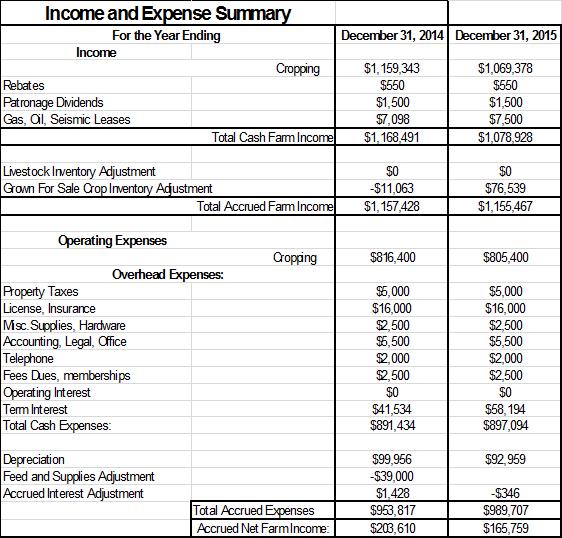
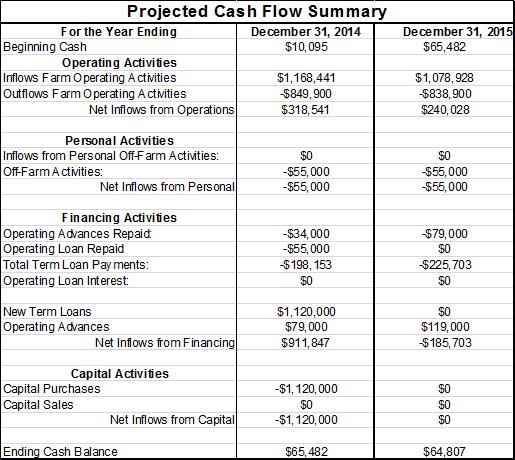
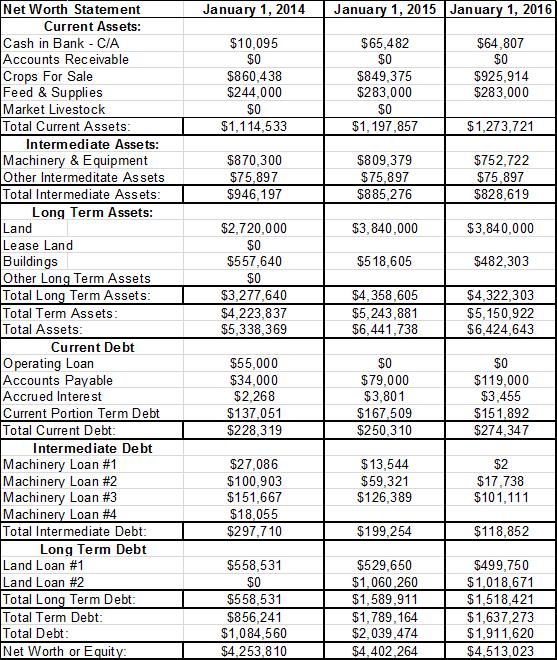 |
|